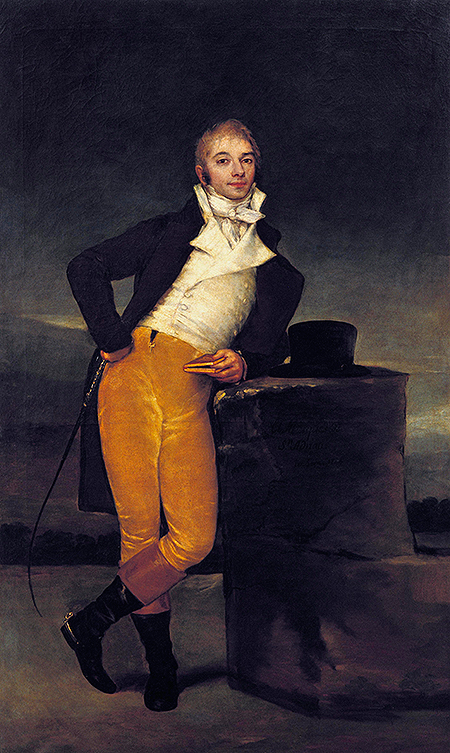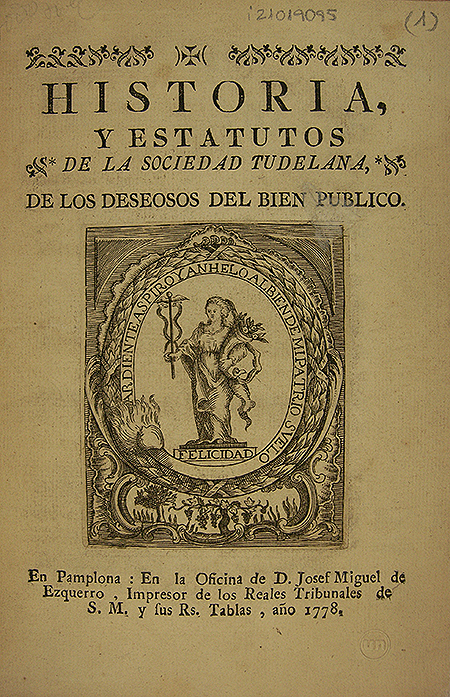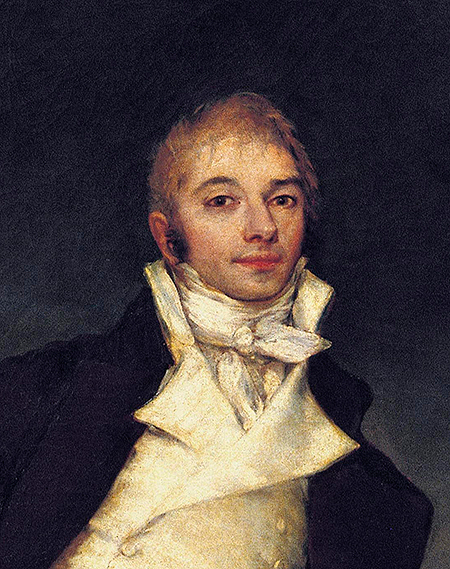25 August
lecture series
FOUR PERSPECTIVES ON THE CULTURAL HERITAGE OF TUDELA
An unknown character for a universally famous portrait: the Marquis of San Adrián
D. Pablo Guijarro Salvador
Chair of Navarrese Heritage and Art
José María Magallón y Armendáriz, 7th Marquis of San Adrián (1763-1845), is a figure known throughout the world thanks to his portrait, painted by Francisco de Goya in 1804 and today on display in the Museum of Navarre. Art historians agree that it is one of the Aragonese painter's finest works.

Photo. 1. Portrait of José María Magallón y Armendáriz, VII Marquis of San Adrián, by Goya, 1804.
(Photo: Museum of Navarre. Larrión & Pimoulier)
Goya developed a special ability to reveal the true personality of his sitters through their gazes and gestures. In the case of the Marquis of San Adrián, the painting reveals a cheerful, vital, intelligent, elegant and sophisticated man, an accomplished horseman who was still attractive at the age of 41. What the expression, attire and symbolism of the objects tell us has so far served to cover the absence of a biography that delves into the life of the Marquis. Recently, the book by the lecturer El espíritu ilustrado en Navarra: los marqueses de San Adrián y la Real Sociedad Tudelana de los Deseosos del Bien Público, published by the Government of Navarre, analyses the dazzling social rise that took José María Magallón y Armendáriz from Tudela to the Court, where he would commission Goya to paint his portrait.
During his childhood and adolescence, the Marquis became acquainted with the environment of the Tudela's enlightened focus, which would give rise to the only Economic Society of Friends of the Country of Navarre, promoted by his grandfather and his father. Both were personally in charge of his first Education and decided to send him to seminar de Vergara and Paris in the company of a tutor, which involved considerable expenses paid for by selling the family's silver and jewels. Between 1782 and 1785 the Marquis attended classes in Vergara at the most prestigious educational institution of the time, where he learned modern disciplines, languages and courtly skills, such as dancing, music, fencing and horsemanship. During those years he stayed at the home of the Marquis of Narros, founder and secretary of the Sociedad Bascongada, who was a great friend of his father.

Plate 2. History and Statutes of the Sociedad Tudelana de los Deseosos del Bien Público, 1778.
(Photo: Archive. Library Services de Humanities. University of Navarre).
He arrived in Paris in October 1786 at the age of 23. He was accompanied by a French tutor who had served as secretary to the Swedish and Prussian embassies. The plan educational included classes in modern sciences, such as physics, Chemistry or botany, and visits to artists and craftsmen for instruction in the fine arts and industry, respectively. However, the Marquis would learn the most important lessons for his future in the aristocratic salons, to which he was invited thanks to his good character and people skills. One of the houses he attended most frequently was that of Francisco Cabarrús, where he coincided with his daughter Teresa and the playwright Leandro Fernández de Moratín. The increase in expenses would end with the trip to programs of study in May 1788, much earlier than the four years initially planned.
His stays in Vergara and Paris were the best preparation for his marriage to María Soledad Rodríguez de los Ríos, Marquise of Santiago, one of the richest noble titles of the time. The Marquis became one of the best hosts of balls and comedies, attended, in his own words, by "all of visible Madrid". His palace also hosted courtesy visits and get-togethers in which aristocrats and literary celebrities took part. The Marquis's correspondence mentions personalities such as Manuel Godoy, the Infante of Parma, Jovellanos, the Countess-Duchess of Benavente, Cabarrús, the poet Tomás de Iriarte, the fabulist Félix María de Samaniego, the physician Ignacio María Ruiz de Luzuriaga, the lawyer Vicente González Arnao and the ambassadors of the French Republic.
The palace of the Marquises of Santiago at degree program de San Jerónimo treasured numerous works of art, including paintings by El Greco, Velázquez and Murillo, as well as a portrait of the child Marquise by Goya, now lost or unidentified. The collection would be enriched by the portraits of the couple, commissioned by the Marquis San Adrián at the time of his greatest triumph staff, following the granting of the grandeur of Spain - the highest dignity of the Spanish nobility - in 1802.
The relaxed pose of the marquis and his frank, direct gaze, similar to that of other models who were friends of Goya's, lead to the question of whether the relationship between the two, documented during the time of their exile in Bordeaux, already existed at the time the portrait was painted. In Bordeaux, where he took refuge from the persecution of the French and liberals, the Marquis of San Adrián acted as a leader of the exiles, who were joined by the Aragonese genius in 1824. This closeness to Goya has even led to his involvement in the famous legend of the disappearance of the painter's skull.

Plate 3. Goya was able to capture the vitality, distinction and attractiveness of the Marquis of San Adrián, qualities that enabled him to occupy a prominent place in the intense social life of the court.
(Photo: Museum of Navarre. Larrión & Pimoulier)
All these data that we now know about the figure of the Marquis of San Adrián correspond to what Goya told us through his brushes. The enlightened spirit of the gatherings in Tudela, the skills learned at seminar de Vergara and the life of society among the Parisian aristocracy forged a man of captivating personality and refined tastes who, after his marriage to the Marquise de Santiago, would shine as one of the best hosts of the Court and would surround himself with a circle of first-rate Frenchmen.
